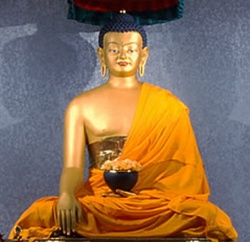Western most spread of Buddhism
According to his edict issued in 256 BCE, King Aśoka sent religious missions to Syria, Egypt, Macedonia and Cyrene. It is not known if any of these missions reached their destinations or if so, whether they had any lasting effect. By the 1st century CE Buddhism was already spread widely throughout Central Asia and two centuries later had a significant presence in Iran. The city of Merv in Turkmenistan used to be a major stop on the Silk Road and at one time was the home of the great poet and mathematician Omar Khayyam. In the southeast corner of the old city are the ruins of a large stūpa and a monastery. The city was destroyed by the Mongols in the 13th century. Merv is situated at 37.34 N and 61.52 E and thus these monuments are the westernmost archaeological evidence of Buddhism from ancient times.
However, literary evidence shows that Buddhism reached much further west than this, as far as Tabrīz in northwest Iran. King Arghum (1284-91) was a generous patron of Buddhism. After his death chaos broke out due to Mongol invaders and fighting between his sons. Ghazan, the oldest son, eventually emerged victorious and although brought up a Buddhist, on the 19th of June 1295, just a few months before ascending the throne, he converted to Islam. Records state that after he entered Tabrīz he ordered all churches, synagogues and temples to be destroyed.
The fate of Buddhism and other religions in Ghazan’s domain is recorded in an ancient Persian work, the Jāmi al-tawāīkh. ‘When Ghazan became a Muslim he commanded all the idols to be broken and all the Buddhist temples (but-khāna) and shrines destroyed, the presence of which in Muslim countries is forbidden by sharīa, and that all the monks (bakhshi, i.e. bhikkhū) be converted to Islam. But since God did not aid them, they had no true faith, but were only Muslims outwardly and by necessity, and in their district there were signs of unbelief and aberration. After a time the king perceived their hypocrisy and said to them: “Let those among you who wish it return to India, to Kashmir or to Tibet or to those countries whence you came. Let those who remain here cease to be hypocrites. And if it should come to my ears that they are building fire altars (i.e. Zoroastrian temples) or temples I will without hesitation put them to the sword.”’ Buddhism lingered in Iran for another few decades before disappearing completely. See Sulawesi Buddha.
‘Buddhism Among Iranian Peoples,’ R. E. Emmerick, in The Cambridge History of Iran, Vol. 3, 1983.
